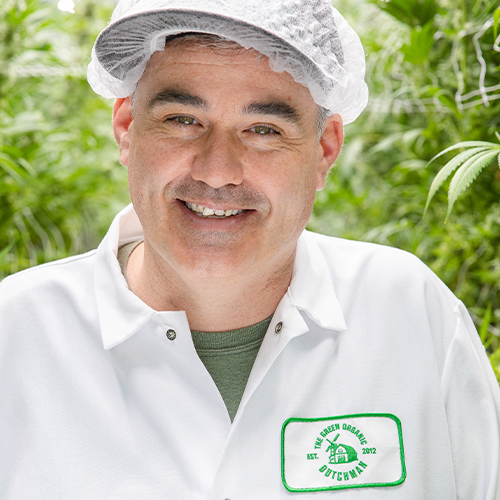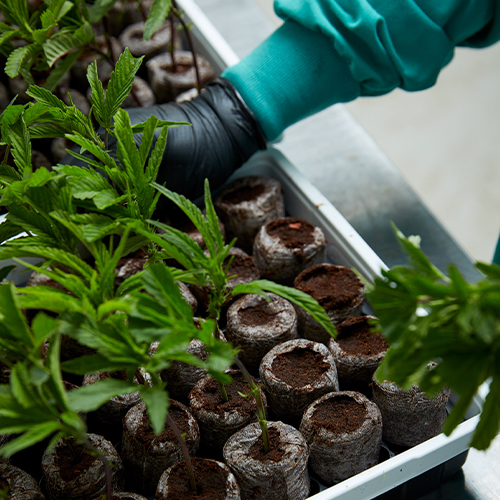When Kris LeBlanc joined TGOD as master grower, he brought with him 15 years of organic growing experience. Here he shares why — and how — he keeps the green… green

Kris LeBlanc has always grown cannabis organically, starting in the early aughts when he was cultivating under Canada’s Marihuana Medical Access Regulations. But after attending a cannabis conference in California in 2009, he decided to make a surprising career switch — to vegetable farming.
“A gentleman there made a comment that if you want to learn how to grow cannabis, you should grow other plants,” says LeBlanc. “If you want to learn how to scale up, you should farm.”
For the next nine years, LeBlanc entrenched himself in organic vegetable farming, growing produce for farmer’s markets and restaurants in the Guelph area, where he lives. That experience, he says, taught him how he could grow high-quality, organic cannabis on a larger scale.
“Organic farming taught me how to scale up, as well as taught me more about the science of plants and organic soil. To trust the plants and yourself,” LeBlanc says. “We all have a green thumb.”
In 2017, LeBlanc returned to the world of cannabis production, putting his upgraded skills and niche expertise to use at different cultivators before settling at The Green Organic Dutchman (commonly known as TGOD) in January 2021. Although there isn’t yet a cannabis-specific organic certification program, TGOD is certified organic by Pro-Cert, a third-party certification body accredited by the Canadian Food Inspection Agency. TGOD has its own proprietary organic growing process called CleanCraft™; with his many years of experience growing both organic cannabis and vegetables, LeBlanc was a quick study.

CleanCraft starts with living soil. Rather than feeding the cannabis plants nutrients such as salt fertilizers and ammonium nitrate (a common cannabis production practice), TGOD enriches the soil with micro-organisms created by brewing a compost tea of worm castings (an organic fertilizer made from earthworms), water, maple syrup and fish oil. This special brew is added to the soil on a weekly basis. LeBlanc compares the process to fallen leaves fertilizing the earth below. “They’re always creating micro-organisms,” he says. “The micro-organisms are doing the work for us, and they’re what’s actually bringing the nutrients to the plants.”
Creating TGOD’s nutrient-rich soil is a cyclical process. After harvesting the plants, the team removes their root balls and adds them to an outdoor compost pile, to be used on TGOD’s organic community farm. Then, they add Canadian-sourced kelp, crab and glacial rock dust to the troughs of soil in the grow room and drill holes in the soil before planting the next batch of plants. It’s a laborious step, but one that enriches the soil and avoids having to use multiple growing containers, which is the case in many conventional growing processes.

“Every week [in other jobs], I’d be putting a dumpster of garbage out the door,” LeBlanc says. “Here, we don’t put any garbage out the door. It’s a great story for the earth, but it’s also just really good, lean farming.”
All of TGOD’s plants are grown indoors at its hybrid greenhouse in Ancaster, Ont. LeBlanc and the cultivation team grow plants in batches of about 4,280 without chemical rooting hormones to boost the plants’ growth.TGOD does use some pesticides (approved by Health Canada and permitted by Pro-Cert) but prioritizes “beneficial biologicals” — good insects that eat detrimental insects.
A combination of sunlight and full-spectrum LED lights nourish the plants, along with naturally purified recaptured rainwater. “Plants transpire 90% of their water back into the air. We collect all the condensation in our HVAC units and return it back to the storage pond,” LeBlanc explains. “All of the irrigation run-off in the greenhouse is brought back to the irrigation room, then filtered for soil and reintroduced back into the irrigation system. Nothing from our nutrient-rich soil gets wasted.”

Come harvest time, only the top colas of each plant are selected (by hand) before being hand-trimmed, then slow-dried and cured. Sustainable glass jar packaging allows the buds to continue curing as the product makes it way to consumers.
Growing organically means LeBlanc and his team must be picky about which cultivars they choose to grow; not every cultivar is well-suited to TGOD’s unique growing system. Selecting new cultivars to bring to market is a collaboration between LeBlanc’s cultivation team and the TGOD marketing team. First, the marketing team monitors industry trends and collects input from the market to decide what’s desirable. Then, the cultivation team is tasked with testing out small batches of a few different genetics to see what will grow well. The goal is to continuously have four to six unique offerings on the market at a time.

When TGOD brought LeBlanc onboard, they gave him one objective: increase the THC potency of their offerings using the CleanCraft system. He rose to the challenge. “I’m happy to show anybody the chart of the yield and the THC numbers going up after [my arrival],” LeBlanc says.
Because of the demand for high-THC strains, TGOD doesn’t send anything to market that’s below the range of 19% to 23% THC, LeBlanc explains. Hitting the desired range takes organization and patience, plus a trained eye to know when it’s time to harvest.
“We do not harvest [according to] an Excel spreadsheet,” says LeBlanc, explaining that there have been occasions when scheduled harvests have purposely been delayed to give the plants more time. LeBlanc makes the call about when they’re ready.
“That was something [management] told me from the start — ‘You’re the one that decides when it’s ready.’ So, we use my eyes. I look at the trichomes. [Go time is] specific to the strain and sometimes specific to the season. But I look at the colour and the cloudiness of the trichomes. That’s really been a big part of our success.”
TGOD’s myrcene-heavy, indica-dominant Organic Maple Kush, for example, tends to take longer than the fruit-forward Organic Sugar Bush or Organic Cherry Mints sativa-dominant hybrid strains. “We’re really happy that we take the time to slow it down, because that last Organic Maple Kush was [up to] 29%,” Leblanc says. “Wow.”
LeBlanc’s rich expertise in organic growing has been a boon to TGOD, but he’s quick to credit teamwork for the company success.
“I have an alternate master grower that’s 27 years old, his name’s Casey, and he is going to be the Wayne Gretzky of the industry. He’s a big part of it,” LeBlanc says. “Rebecca, Megan, John — they’re all a huge part of it. They’re all huge cannabis people and they absolutely commit themselves to the plants and the place.”


